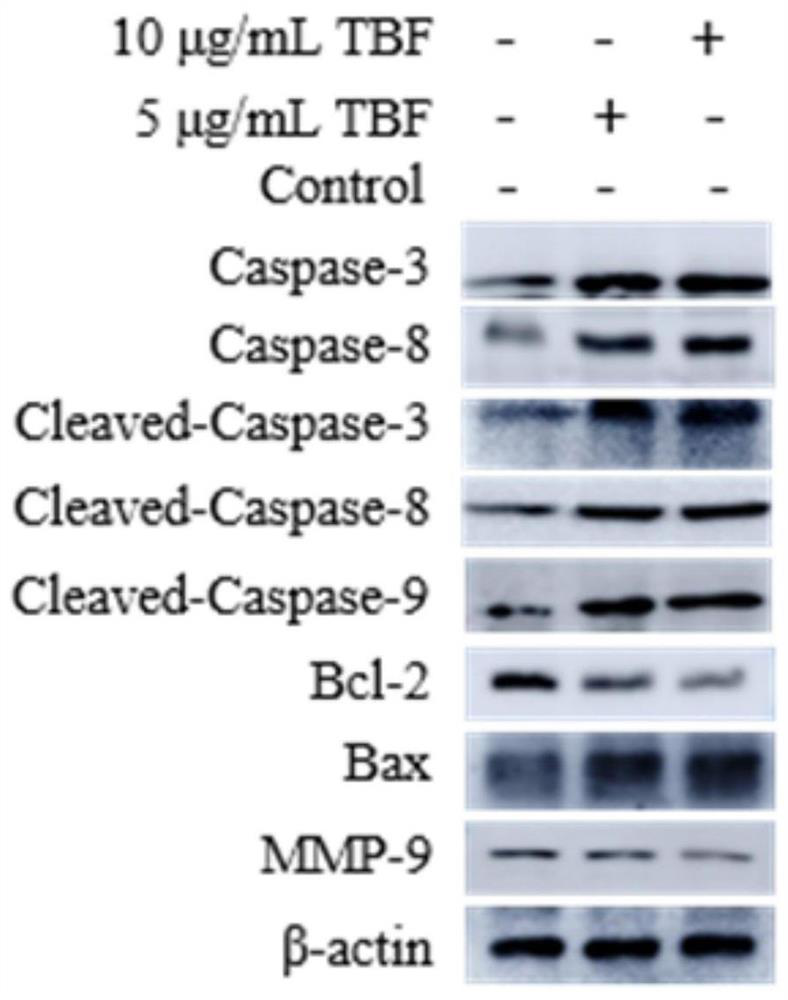Application of tartary buckwheat flavone in preparation of medicine for treating pancreatic cancer
A technology for tartary buckwheat flavonoids and pancreatic cancer, which is applied in the field of pharmaceutical industry, can solve problems such as large side effects and cannot be completely cured, and achieve the effects of low toxicity and side effects, reduction of diagnosis and treatment costs, and strong operability.
- Summary
- Abstract
- Description
- Claims
- Application Information
AI Technical Summary
Problems solved by technology
Method used
Image
Examples
Embodiment 1
[0052] Preparation of Tartary Buckwheat Flavonoids
[0053] Extract tartary buckwheat flour in ethanol with a concentration of 63% for 2 hours at a temperature of 70°C, filter with a multi-purpose vacuum pump for circulating water, collect the supernatant, and concentrate using a rotary evaporator for 30 minutes at a temperature of 60°C to obtain the extract, and then use 28% ethanol to dissolve the extract;
[0054] At room temperature, wash the AB-8 macroporous adsorption resin with 98% ethanol and put it on the column, inject the extract solution dissolved in ethanol into the column, and let it stand for 2 hours. After the end, slowly elute with water, discard Remove the washing liquid, then elute with 60% ethanol, collect the eluent, recover the ethanol under reduced pressure, concentrate and dry the tartary buckwheat flavonoids, and the obtained powder is the extracted tartary buckwheat flavonoids, which is analyzed by HPLC to obtain The content of total flavones in the ...
Embodiment 2
[0056] cell culture
[0057] Take out the complete cell medium (DMEM medium, purchased from Gibco, USA) 30 minutes in advance and return to room temperature, inoculate 10% fetal bovine serum and 0.1% penicillin-streptomycin in the DMEM medium to obtain 10% fetal bovine serum and DMEM medium with 0.1% penicillin-streptomycin double antibody. Afterwards, PANC-1 cells (pancreatic carcinoma ductal cells, purchased from American Type Culture Collection (ATCC, Manassas, VA, U.S.) in DMEM medium at 37°C, 5% CO 2 Cultured in a cell culture incubator. The medium was changed every 24 hours, and the PANC-1 cell culture operation was completed when the PANC-1 cells were in the logarithmic growth phase, and the cultured PANC-1 cells were collected for use.
Embodiment 3
[0059] Western Blot western blot detection
[0060] Get the PANC-1 cell that embodiment 2 cultivates and obtain, be divided into 3 groups on average, each group is inoculated in the 96-well plate after being digested with 0.25% trypsin, and each group has 6 duplicate holes, until the PANC-1 cell grows to 50~ When the density is 60%, perform Western Blot detection according to the following steps:
[0061] The first group: PANC-1 cells at the end of growth were not treated with any drugs, the total protein was extracted with RIPA cell protein lysate (purchased from Beyond Biotechnology Co., Ltd.), and the BCA detection kit (purchased from Beyond Biotechnology Co., Ltd.) company) to detect protein concentration. After the protein sample was quantified, it was mixed with Loading Buffer (5X) (purchased from Beyontian Biotechnology Co., Ltd.), boiled at 99°C for 10 minutes, and then used. SDS-PAGE electrophoresis, after the electrophoresis, put it into the transfer tank, store it...
PUM
 Login to View More
Login to View More Abstract
Description
Claims
Application Information
 Login to View More
Login to View More - R&D
- Intellectual Property
- Life Sciences
- Materials
- Tech Scout
- Unparalleled Data Quality
- Higher Quality Content
- 60% Fewer Hallucinations
Browse by: Latest US Patents, China's latest patents, Technical Efficacy Thesaurus, Application Domain, Technology Topic, Popular Technical Reports.
© 2025 PatSnap. All rights reserved.Legal|Privacy policy|Modern Slavery Act Transparency Statement|Sitemap|About US| Contact US: help@patsnap.com



